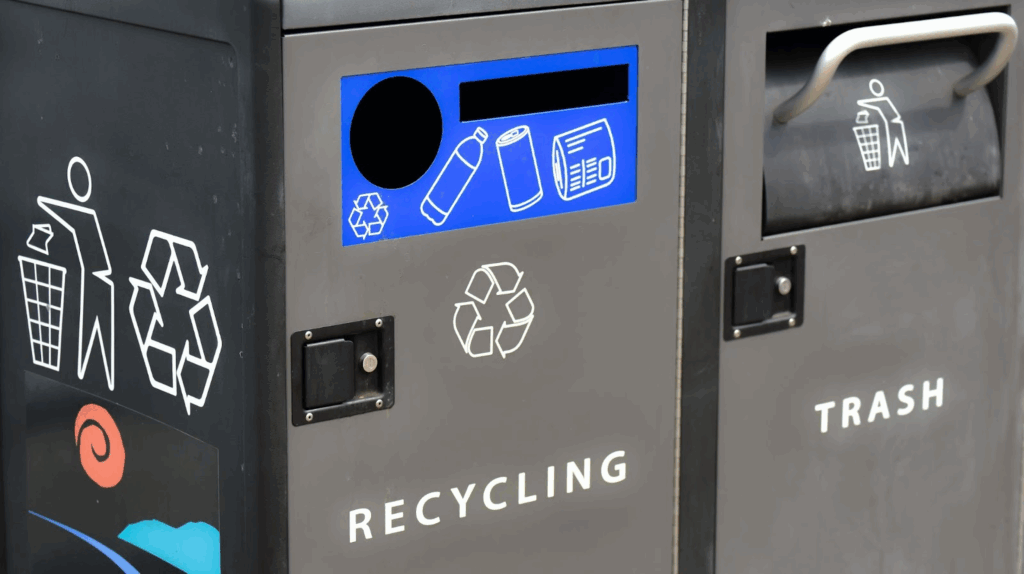Most businesses want to recycle more, but few have the time to manage a complicated system. Even well-intentioned efforts often fall short between shifting teams, multiple waste bins, and unclear rules. Single-stream recycling offers a more straightforward approach by removing the sorting step at the source. It’s built for fast-paced environments where ease of use drives consistent results.
What is Single-Stream Recycling and How Does it Work?
Single-stream recycling allows all recyclables, such as paper, plastics, metals, and cardboard, to be placed in one bin instead of being sorted by type. This system removes confusion at the source, making it easier for teams to recycle without needing training on multiple waste streams. Collected materials are later separated at a Material Recovery Facility using industrial equipment such as optical sorters, magnets, and air jets. Businesses choose this method to improve recycling rates, save time, and reduce mistakes across departments.
How Material Sorting Happens at Facilities
Once collected, mixed recyclables are delivered to a processing facility and sorted by type using automated systems. Technologies like optical scanners identify plastic grades, while magnetic systems pull metals from the stream. Contaminants, such as food residue or plastic bags, are manually separated or filtered out early. If too many non-recyclables are mixed in, entire loads may be rejected. That’s why keeping recycling bins clean and limiting non-qualifying waste is essential—a clean load results in higher recovery and better sustainability outcomes.
Why Businesses Prefer Single-Stream Recycling
Businesses prefer single-stream recycling because it streamlines waste collection and improves department participation. By using a single container for all recyclable materials, teams no longer need to sort items at the source, thereby simplifying training and reducing errors. Facility managers benefit from fewer bins, less oversight, and more consistent compliance with recycling programs. This approach saves time, reduces costs, and helps businesses meet environmental targets without overcomplicating daily operations.
Simplified Systems Support Workplace Sustainability
Removing multi-bin setups makes recycling more intuitive and less time-consuming for staff. When the process is easy to follow, employees are more likely to use the system properly. Janitorial teams also benefit from faster bin collection and fewer sorting mishaps. Clear bin labeling and occasional reminders keep contamination low and volumes high. Over time, this ease of use translates into stronger workplace habits and a more sustainable business culture. Simplicity drives success in recycling programs.
What You Can and Can’t Recycle in One Bin
Accepted materials in single-stream recycling usually include clean paper, flattened cardboard, rigid plastics, tin, and aluminum cans. These items are commonly found in offices, warehouses, and storefronts. However, contamination remains a challenge, especially when mixed in food-soiled containers, Styrofoam, or plastic bags. These items jam machinery or degrade the quality of sorted materials, making them costly to process or unrecoverable. All recyclables should be empty, clean, and dry to avoid rejections at the recovery facility and to maintain the value of the materials collected.
Avoiding Contamination Through Clear Guidelines
Recyclables must be free of liquids, grease, and other contaminants to stay viable for processing. For example, food residue on a pizza box can ruin an entire paper batch. Likewise, while common, plastic films and flexible packaging should not go into single-stream bins. Clear signage in common areas and employee updates on accepted materials help avoid these issues. Routine checks on bin content can also prevent patterns of contamination. A little education goes a long way in keeping loads clean.
Handling Questionable or Uncommon Items
Some items don’t fall into “yes” or “no” categories, which often leads to confusion at the bin. For example, every program may not accept black plastic containers, paper cups with plastic lining, or certain composite packaging. It’s best to confirm with your recycling provider or local municipality, as accepted materials can vary by region. Businesses can maintain an internal reference list of items often in question, and update it when guidance changes. That keeps recycling practices accurate and reduces guesswork. A shared point of contact or sustainability lead can also help clarify these decisions.

Benefits of Single-Stream Recycling for Workplaces
Single-stream recycling streamlines the recycling process, enabling businesses to increase diversion rates and reduce their reliance on landfills. With fewer barriers to participation, more employees consistently engage with recycling efforts across departments. It leads to cleaner facilities, better waste tracking, and higher volumes of recovered materials while supporting corporate responsibility goals and regulatory compliance. It’s an accessible system ranging from small offices to large multi-site operations.
Improved Efficiency Across Departments
Reducing the number of bins used in a facility creates more open space and less confusion for staff. Janitorial teams benefit from reduced sorting steps and less time handling waste, which improves their workflow. Clean, organized collection stations also leave a better impression on clients, tenants, or inspectors. These details support the business’s brand image as responsible and forward-thinking. Whether a shared office or a logistics warehouse, single-stream helps streamline operations. Cleaner spaces mean clearer systems and smoother routines.
Easier Tracking for ESG and Sustainability Goals
With only one stream to monitor, it’s easier to measure recycling volumes and contamination rates. Many waste providers offer detailed reports on what’s being collected and how much is diverted from landfills. These insights support environmental audits and help with ESG reporting, compliance benchmarks, and stakeholder updates. Leadership teams can use this data to demonstrate progress toward sustainability commitments. Precise tracking helps identify trends, flag issues, and drive continuous improvement. Better data leads to better decisions.
Reduces Operational Waste Costs Over Time
While recycling systems require some initial setup, single-stream options often lead to cost savings. Fewer bins mean lower container rental and maintenance fees. Simplified pickup schedules reduce hauling costs, especially in high-volume locations. Improved employee participation results in fewer contaminated loads and fewer rejected shipments, which helps avoid penalty charges. Over time, efficient recycling can reduce overall waste output. That means smaller landfill pickups and lower total waste bills.
Supports a Stronger Internal Culture
Employees want to work for companies that take sustainability seriously, and easy recycling systems help build that trust. When businesses provide simple tools to act responsibly, staff are more likely to engage and share ownership of the process. Recycling becomes part of the daily routine, not an afterthought. It contributes to a stronger, more connected workplace culture. It also fosters awareness that often extends beyond the office. When people are empowered to act sustainably at work, they carry those habits elsewhere.

Common Single-Stream Recycling Challenges
Contamination remains the most persistent challenge in single-stream recycling systems. When employees place incorrect or dirty items into recycling bins, entire loads may be deemed unusable and redirected to landfills. Over time, this reduces the program’s environmental and financial value. Although Material Recovery Facilities use advanced technology, they can’t compensate for excessive contamination or improper usage at the source. Businesses must take proactive steps to keep their streams clean and effective.
Sorting Technology Has Its Limits
Even with high-tech systems in place, certain materials are still difficult to process. Thin plastic films, straws, shredded paper, and tangled cords can clog machinery and stall operations. These items require separate disposal or specialty recycling streams. When improperly included, they create delays, increase costs, and lower recovery rates. Staff education helps minimize these missteps. Regular audits and visible reminders near collection areas reduce avoidable contamination.
When Single-Stream Recycling Isn’t the Right Option
Businesses that produce specialized or regulated waste, such as food scraps, chemicals, or hazardous items, may not be suitable for single-stream recycling. These materials often require separate handling protocols that fall outside the scope of standard collection. Restaurants, laboratories, and manufacturers may consider a hybrid system that combines single-stream with dedicated waste solutions for specific byproducts. Misplacing such items compromises recovery rates and can lead to safety risks and regulatory fines.
Using Hybrid Systems for Complex Waste Streams
A hybrid recycling model may include a single-stream bin for general recyclables and additional containers for organic waste, electronics, or industrial materials. This method gives teams flexibility without compromising safety or compliance. Conducting a waste audit helps identify what materials are generated and where they end up. Waste providers can also assist in designing systems that match your business’s unique footprint. Matching the right strategy to the right materials keeps operations running safely and efficiently. One system rarely fits all needs.
How to Start Single-Stream Recycling at Your Facility
To successfully implement single-stream recycling, verify that your waste provider offers it, then clarify what materials they accept. Some providers also provide employee training, contamination tracking, and reporting features to support your rollout. Once logistics are in place, businesses should launch internal communications to guide teams through the transition. Start with simple, visual instructions and appoint someone to oversee participation and monitor bin use. Clean dumpsters and clear expectations help the program run smoothly from day one.
Keep Teams Informed and Engaged
Building a successful program depends on ongoing staff involvement. Employees should know which items go in which bin and understand the consequences of contamination. Offering reminders through posters, emails, or quick check-ins can prevent careless mistakes. Recognizing team participation and keeping the recycling process transparent also improves long-term buy-in. When employees understand the why and the how, participation becomes second nature. Consistency is what keeps the system effective and sustainable.
Make the Switch to Smarter Recycling Now
Companies that take recycling seriously stand out in the eyes of clients, customers, and employees. Sustainability is no longer a niche concern, but a baseline expectation in modern business. Relying on outdated or unclear systems sends the wrong message, while single-stream recycling provides a reliable, visible way to reduce waste. The sooner your business evaluates its recycling process, the faster you can make tangible improvements. It’s about making recycling easier, more effective, and aligned with your organization’s operations today.
Looking to clean up more than just your waste bins? Explore the Top Dog Waste Solutions blog for innovative, sharper recycling know-how.








